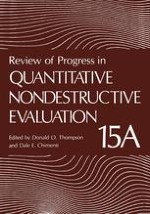1996 | OriginalPaper | Buchkapitel
Quantitative Measurement of Metal Loss Due to Corrosion in Aluminum Aircraft Skin
verfasst von : D. K. Hsu, T. C. Patton, V. Dayal, B. L. Hinzie, J. N. Gray
Erschienen in: Review of Progress in Quantitative Nondestructive Evaluation
Verlag: Springer US
Enthalten in: Professional Book Archive
Aktivieren Sie unsere intelligente Suche, um passende Fachinhalte oder Patente zu finden.
Wählen Sie Textabschnitte aus um mit Künstlicher Intelligenz passenden Patente zu finden. powered by
Markieren Sie Textabschnitte, um KI-gestützt weitere passende Inhalte zu finden. powered by
The detection and characterization of corrosion is one of the many challenges in the nondestructive inspection (NDI) of aging aircraft. A number of groups are pursuing ultrasonic techniques for the detection and evaluation of corrosion in such aluminum fuselage structures such as lap splices and tear straps [1]. Under the FAA-Aging Aircraft Research Program, Patton and Hsu [2–4] at Iowa State University have developed the capability to apply high resolution, water-coupled, focused-beam ultrasonic NDI to aircraft fuselage structures in a maintenance hangar environment. The method, known as the “Dripless Bubbler” technique, is a combination of focused-beam immersion ultrasonics with a portable ultrasonic scanner. With the Dripless Bubbler, B- and C-scan images of the aircraft fuselage may be acquired using both high frequency and low frequency immersion ultrasonics typically only reserved for the laboratory. In this paper, we present results on corrosion detection in the outer aluminum skin of a fuselage lap splice section using high frequency (15 MHz nominal center frequency) immersion ultrasonics, and compare these results against those obtained from collimated-beam X-ray attenuation measurements. This comparison has been quite instructive and revealed several important considerations in the interpretation of both ultrasonic and X-ray data when applied to the quantitative measurement of metal skin thickness.
